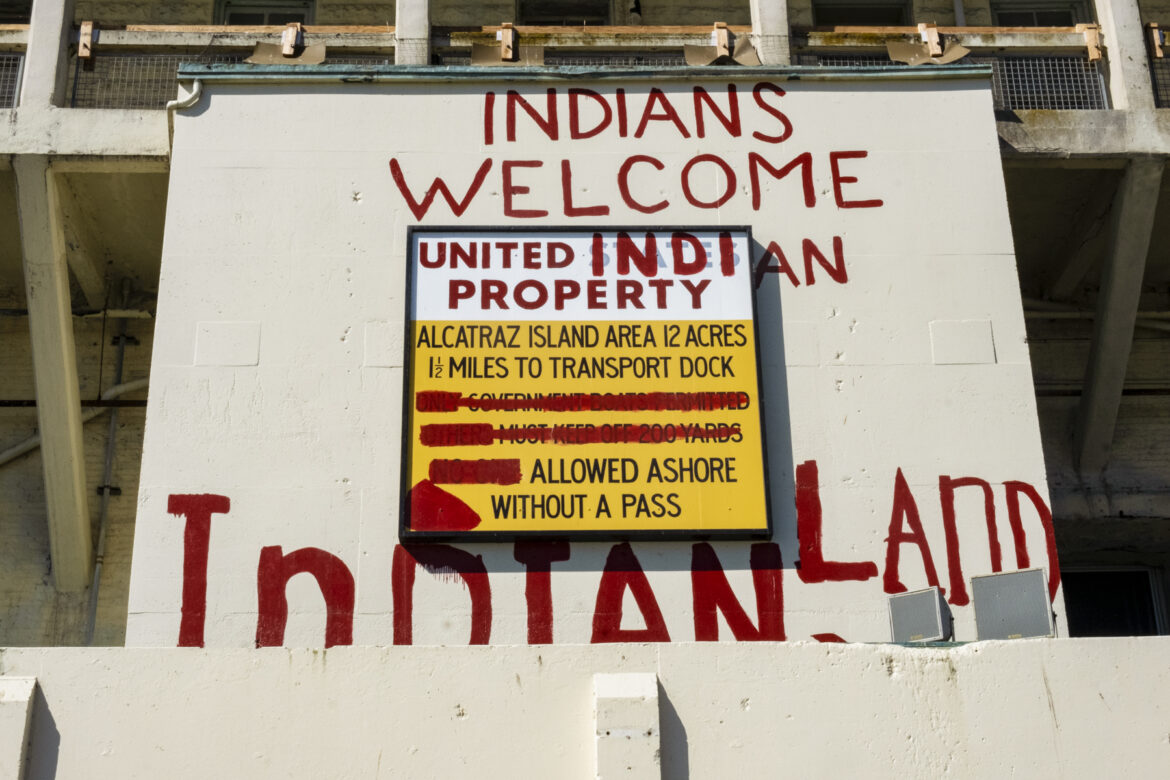When learning about memorial landscapes and the metaphors used to scrutinize these places of memory, my mind immediately went to Alcatraz Island and its role as an arena. According to Cynthia D. Smith and Teresa Bergman, “Places like Alcatraz Island occupy physical space and therefore provide tangible evidence of the past with which visitors can interact” (165). What tangible evidence of the past is being presented and interacted with at Alcatraz?
I visited San Francisco this past August, and while I did not step foot on Alcatraz or within its buildings, I did witness the “must-see” tourist attraction from the outside via boat. Apart from the isolated nature of the prison buildings, I noticed what was written on the walls— “Indians Welcome, You are on Indian Land”—bright red words painted by a group of Native Americans that occupied the island from November 20, 1969 to June 11, 1971. At the time, when the boat sailed past the island, I was not fully aware of the Native American Occupation of Alcatraz Island. For context, “On November 20, 1969, ninety men and women, calling themselves the Indians of All Tribes, issued the ‘Proclamation of the Indians of All Tribes,’ which pledged to transform the former federal prison into an American Indian cultural center, spiritual center, and museum, and then took over the island. For nineteen months, the protestors operated a school, day care, and health center. The number of occupiers eventually peaked at 400” (Bauer). The Native American protestors strategically used the landscape and its association with suffering, inscribed in the island, to speak on environmental injustice; they used a collectively recognized past memory to express present strife. “The ‘Proclamation of the Indians of All Tribes’ recognized environmental issues in Indian Country. After claiming the island, the Indians of All Tribes compared the environmental conditions on reservations to the former prison, ‘this so-called Alcatraz Island is more than suitable as an Indian Reservation, as determined by the white man’s own standards’” (Bauer).

The occupation was as foreign to me as the rest of San Francisco. However, I was familiar with the narrative of Alcatraz Island that films, media, and the government have shaped to be the dominant memory: a chilling, impossible-to-escape, maximum security prison and penitentiary. Smith and Bergman further discuss the popularization of this idea of Alcatraz, “Most visitors to Alcatraz have some familiarity with the island’s use as a federal penitentiary, which is amplified through the shared public experience of touring this memory site” (165).
In contrast to the heavy emphasis on “governmental authority, …visitors are denied the opportunity to publicly experience spaces relevant to the Native American Occupation. In the absence of such experiences, visitors are unlikely to identify with those who occupied the island or with the counter narrative offered by their story of civil disobedience as a response to the governmental abuse of power” (Bergmann and Smith). The graffitied phrases are the extent to which the Native American story is memorialized. In contrast, “the prison’s history and its ideology of incarceration are instantiated through the multitude of buildings on the island; the
Native American history of the island is represented by painted graffiti. These material traces of the past on Alcatraz are by no means equally compelling rhetorical resources…Even though Alcatraz’s varied historical past is well represented in banners, exhibits, and film, there are several powerful physical elements that work to diminish any memory of the site’s history as other than a federal penitentiary” (169, 160). Does this miniscule attempt to memorialize the Native American Occupation fall in line with the “we’ve done enough” excuse?
The Native American Occupation of Alcatraz Island was historic, groundbreaking, and profoundly instrumental in future non-violent acts of civil disobedience such as “such as Pit River People on PG&E land” and other “acts of cultural self-determination,” but its influence is not felt at the site itself (Bauer). According to Dwyer and Alderman, “The ability to commemorate the past is limited by competition and conflict among parties of social actors wishing to narrate the past differently.” This political contestation of the island makes Alcatraz act as an ‘arena’ where the Native American experience is fighting to be remembered, battling with other variations of memory associated with the island that have taken the spotlight. Specifically, “at Alcatraz Island, the physical and sensorial experience strongly shapes the constructed historical memories and focuses visitors on the disciplinary power of the state rather than the resistance efforts of the Native Americans” (Bergman and Smith).
The questions I ask all of you are: Why do you think the Native American experience with the island has been forgotten? Is the preservation of terracotta graffiti enough? Is the construction of a memorial experience geared away from the Occupation intentional? What can be done to reinscribe the Native American memory back into the island?
References:
Bauer, William J. “The Occupation of Alcatraz Island and Environmental Injustice in Indian
Country.” UC Press Blog, 8 Oct. 2021, www.ucpress.edu/blog/56876/the-occupation-
of-alcatraz-island-and-environmental-injustice-in-indian-country/.
Bergman, Teresa, and Cynthia D Smith. Places of Public Memory the Rhetoric of Museums and
Memorials. University of Alabama Press, 2010.
Dwyer, Owen J., and Derek H. Alderman. “Memorial landscapes: Analytic questions and
metaphors.” GeoJournal, vol. 73, no. 3, 2008, pp. 165–178, https://doi.org/10.1007
/s10708-008-9201-5.




